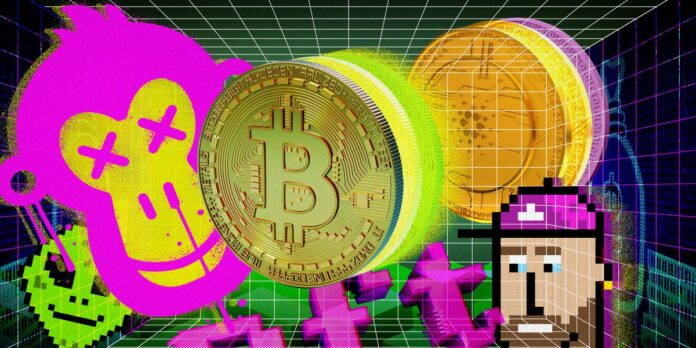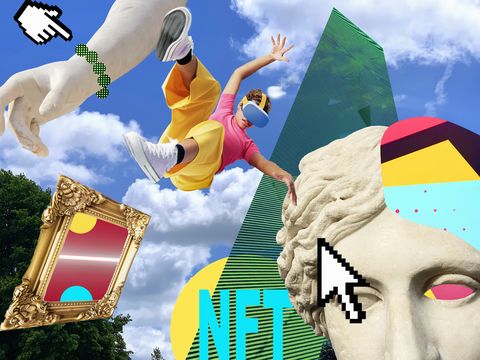In the Shondaland series Financially Fearless, we’re getting candid about how money impacts everyone’s lives. Our solutions will detail how to boost your financial wellbeing, trim overspending, craft a budget, and discuss money matters with loved ones.
In the world of money, you likely have seen and heard that cryptocurrencies, the blockchain, and other digital assets are the future. But where do these new moneys and digital assets stand in terms of real value?
Since the established adoption of Bitcoin, the most widely used cryptocurrency in the world, in 2017, the financial sector has found itself in the face of evolution. As a wealth of other cryptocurrencies and other digital assets, like NFTs, springs up, consumers are being offered entirely new ways to own and use money, moving beyond banks and traditional financial institutions.
When Bitcoin was invented in 2008, the idea was to disrupt financial power by creating a new system of money that defied government-regulated methods of owning and saving money. Cryptocurrency does that by existing as a digital currency on a computer network that does not require or rely on a government, bank, or otherthird party to monitor, organize, or maintain it. Because crypto is exchanged outside of these types of institutions without traditional regulations — via, for example, interest rates, money printing, and circulation, and how much money is reserved in banks — it has been widely adopted across the world by those who would rather exchange currency on a freer market. As such, cryptocurrencies saw a long stretch of phenomenal growth, with coins like Bitcoin, for example, being traded at $68,789 U.S. dollars per 1 Bitcoin at its peak.
But the party, seemingly, couldn’t last forever. Such lack of regulation is also one of the reasons that, in the past 18 months, the blockchain technology-based economy has come under extreme duress, with the total crypto market value reduced from $3.2 trillion to less than $1 trillion since November 2021.
So, how did we get here?
Where are we headed when it comes to the future of crypto, NFTs, blockchain technologies, and any other financial disruptors that, despite any setbacks, are still trying to transform the way we gain, use, and trade our finances?
Let’s start at the beginning: What is blockchain technology?
In simple terms, blockchain is a type of technology that organizes digital information in blocks of data that are connected across multiple computer systems in multiple places, which is also referred to as a peer-to-peer network.
The blockchain functions as an electronic ledger on which digital assets, like cryptocurrencies, can be recorded as transactions that are distributed across all the computers on the network. This blockchain data on the network cannot be replaced or destroyed, and it is also decentralized, meaning wealth or ownership of the asset is free of banks and other third parties.
Blockchain tech made cryptocurrencies possible.
What are cryptocurrencies?
Cryptocurrencies are digital or virtual currencies that are secured on a blockchain with encryption algorithms, or cryptography.
One of crypto’s biggest and considerably most attractive features is that it uses a decentralized system to record new transactions and issue new units of currency. As a decentralized digital asset, cryptocurrencies are not issued or regulated by a government or central authority, but rather are organized and exchanged by the currency holders themselves. There are presently thousands of cryptocurrencies all over the world, with new coins being regularly announced.
What is Bitcoin?
Bitcoin is the first-ever cryptocurrency. It is also currently the largest crypto on the market due to its longevity, credibility, security, and simple transaction process. It was introduced in 2008 through a white paper that explained the merits of blockchain technology as a means of digital currency by a person or group who used the pseudonym Satoshi Nakamoto (to date, no one knows who Satoshi Nakamoto was or is). Bitcoin officially launched in 2009. While Bitcoin was and still remains the most popular and highest-priced coin among cryptocurrencies, others soon followed, like Litecoin (LTE), which launched in 2011, and Ethereum (ETH) coming soon after in 2013. At their peaks throughout 2021, Bitcoin, Litecoin, and Ethereum were exchanging, per 1 digital coin, to $68,789 (Bitcoin), $256 (Litecoin), and $4,800 (Ethereum) in U.S. dollars, respectively.
Cryptocurrencies: What the future looks like
The great crypto crash over the last 18 months is the culmination of varying factors: There was the Terra Luna coin crash, which, after two cryptocurrencies, TerraUSD and Luna, lost 80 percent of their worth, consequently wiped out $18 billion in crypto market capitalization; fluctuations in the equity market, which saw big players like Apple, Amazon, and Tesla dip by more than 6 percent, which invariably had an effect on the crypto pricing, revealing newfound sensitivities between the crypto and stock markets; and most importantly, following news of the U.S. inflation hitting its highest point in 40 years, the Federal Reserve was forced to raise interest rates, causing a frenzy across financial markets.
Given all this, assets perceived to be risky by professional investors — like cryptocurrencies — took a lot of the fall.
Many traders resorted to selling off their cryptocurrency holdings and reinvesting in seemingly safer and more stable assets. In June 2022, the value of one share of Bitcoin dropped below $18,000. Ethereum and Litecoin soon followed suit, plunging below $1,000 and $52, respectively. In total, since November 2021, the total crypto market value reduced from $3.2 trillion to less than $1 trillion.
It was (and still is) a jittery period for crypto traders, who were wondering if the worst had come as they tried their best to cope with the loss of more than 18 months of growth. Since June 2022, the crypto markets have continued to fall, and September was especially nightmarish for many traders as major digital coins lost value.
The result is endless debates about crypto’s uncertainty, with critics who have always chided its volatility, with some concluding that it’s just another Ponzi scheme, while other traders still believe that the future for crypto is hopeful.
What the optimists say
“As any asset class, digital assets are at the mercy of the asset market in general. We used to think that crypto would be independent of the greater economy, and therefore would be a good way to hedge against asset losses,” Alex Jimenez, a financial consultant and managing principal of EPAM Systems, a digital business consulting firm, tells Shondaland. “Clearly, that isn’t true. As worldwide markets struggle, ultimately digital assets as a class will grow, and stability will be up to the general market.” He says we are currently seeing the vulnerability of cryptocurrencies. If dollars, euros, and other traditional moneys are affected by things like inflation, so should we expect cryptocurrencies to be.
Rafal Tworkowski, a financial markets analyst at Conotoxia, a Polish payments institution, thinks cryptocurrencies have strong use cases and will probably be here to stay despite the volatility. “The biggest long-term factors in crypto space development are probably two opposing trends: an increase in blockchain effectiveness and the adoption of Central Bank Digital Currency by central governments,” he says, referring to world governments adopting the use of their own digital currencies alongside traditional currencies. For instance, China has already begun testing with its “e-yuan,” while the EU is considering the introduction of a digital euro by 2025.
But it remains debatable whether crypto will ever be fully adopted and thereby controlled by the government given the fact that the crypto ecosystem defies government-regulated methods of owning and saving money, which originally lead to its widespread adoption predominantly in remote and underdeveloped regions across the world.
In a recent Chainalysis report, for example, 80 percent of all crypto payments of less than $1,000 came from sub-Saharan Africa. The CEO of Money Africa, Oluwatosin Olaseinde, asserts that such widespread use could alternatively instigate a formal integration between cryptocurrencies and finance. “Through concepts such as central bank-issued digital currencies, I believe there will be closer integration with the formal financial space,” she says.
Possible regulation
If cryptocurrencies are further integrated into our current traditional systems of spending, however, they could then open themselves up to the regulation they have long fought against. In the United States, for example, such oversight is already being mulled over by Congress, with Democratic Colorado Senator John Hickenlooper recently saying in an address to the Securities and Exchange Commission: “Whatever the risks and benefits of these new assets might be, existing laws and regulations were not designed to deal with how digital assets are being used in the market. Currently, digital asset markets do not have a coordinated regulatory framework. This creates uneven enforcement and deprives investors of a clear understanding of how they are protected from fraud, manipulation, and abuse. … Given the complexity of these issues, and recognizing that some digital assets are securities, others may be commodities, and others may [be] subject to a completely different regulatory regime, a formal regulatory process is needed now.” For many, this signals that crypto could come under new scrutiny from the U.S. government for how and why it is being used in the financial sector.
But speaking on how cryptocurrencies would be implemented in the future of finance, Jimenez doesn’t see cryptocurrency, as it is today,remaining as actual currency, but rather like any other financial trade or investment asset. “The mistake is to continue to think about crypto as anything else but a store of value, like stocks or with any other asset class.”
What about NFTs?
Elsewhere in blockchain technology, NFTs, or non-fungible tokens, came into limelight in 2017. NFTs are assets that appear as various digital forms of art, music, videos, images, et cetera that are exchanged online, most commonly with cryptocurrency; therefore, NFT value and popularity is directly linked to the rise and fall of the crypto market. Based on their unique identifying codes, NFTs are considered one of a kind, which greatly increases their value as an asset to be used for trading or to purchase other goods and services. For a broader breakdown of NFTs, read here.
Since their peak in January 2022, NFTs have plunged by 97 percent in trading volume. The first quarter of the year recorded a rapid increase in the market trade volume of NFTs, but the year’s second quarter has seen only a decline in relation to the deflation of the cryptocurrency market.
Giancarlo Rios, who directs Web3 marketing at Swapbox, a reusable packaging start-up in Belgium and the Netherlands, says of NFTs’ future, “They will evolve for their original intended use as just tokens that prove ownership tied to real-life goods or services — movie tickets, sports tickets, concert tickets, receipts, medical documents, etc.” In doing so, many experts hope the market will simply stabilize and, like cryptocurrencies, become a traditional part of the investment world now that the initial frenzy has cooled.
In contrast, Tworkowski says, “It seems hard to think of NFTs as an asset of the future. This technology seems to be misused in the financial sector, with little to no benefit.” He believes there could be more potential for it in ticketing systems and loyalty and reward programs, but to him “its future is rather unclear.”
For everyday users of NFTs, Becks Perfect, a Web3 educator and the founder of Nifty World, a secure storage site for NFTs, reiterates that “we’ll see NFTs integrated more into everyday lives, particularly within certain industries — like music and fashion.” She affirms that ticketing-based events and businesses will be one of the first big adopters of NFTs as it has already begun to transform ticketing in concerts by, for example, creating a more in-depth record of attendance process, opening gateways to exclusive experiences for fan-club members, hosting surprise giveaways, and offering not just a ticket to an event, but an interactive digital experience before entering the show itself.
While the real-world applications are taking root, so too are NFTs in the virtual space. With our lives becoming more and more online — and with the launch of the metaverse — there could be entire new markets for digital, well, everything: art, music, games, and real estate. So, for example, a new user of the metaverse could purchase a digital piece of art to hang in their virtual home, which could then be turned into an NFT, which, as a new digital asset, could be sold on the NFT market with cryptocurrency.
What is “the merge,” and what changes will it bring to the crypto ecosystem?
You may have recently heard some buzz in the crypto sphere about what many crypto enthusiasts call “the merge.” On the surface, it is a new, carbon-reducing development in the Ethereum cryptocurrency — but it could have effects on the entire crypto ecosystem.
Since 2015, the Ethereum blockchain has used a system called proof-of-work to record new transactions and other information securely. “Mining,” as it’s called, is also used by other cryptocurrencies, including Bitcoin, and is known to be extremely energy-intensive due to the sheer amount of computing power necessary to verify and complete transactions. For example, over the course of a year, the Ethereum network alone consumed the equivalent energy of some countries, like Austria. But in September of this year, Ethereum switched from proof-of-work to a more sustainable system in a major update called “the merge” — moving to a system called “proof of stake,” which reportedly uses 99.5 percent less energy by using algorithms to better direct computers on how and when to begin computing in order to process transactions.
“With the merge completed, the token team seems able to lower transaction costs, making Ethereum a more affordable way of payment,” Tworkowski says of the new development, which also boasts the boon of a more environmentally friendly way to use and trade cryptocurrency. The test now will be if other crypto energy users — like Bitcoin, which reportedly uses more yearly energy than Kazakhstan — will follow suit and, hopefully, bring green-conscious users with them.
Chidinma Iwu is a Nigerian tech and culture Journalist who has been featured in Paste, The Daily Dot, the Daily Mail, Black Ballad, The Business of Business, asnd more. She’s almost always on Twitter @Chidxnma, tweeting spontaneously and wishing there’s better for women.
Get Shondaland directly in your inbox: SUBSCRIBE TODAY
Credit: Source link























 Bitcoin
Bitcoin  Ethereum
Ethereum  Tether
Tether  Solana
Solana  USDC
USDC  Lido Staked Ether
Lido Staked Ether  XRP
XRP  Dogecoin
Dogecoin  Toncoin
Toncoin  Cardano
Cardano  Shiba Inu
Shiba Inu  Avalanche
Avalanche  TRON
TRON  Wrapped Bitcoin
Wrapped Bitcoin  Bitcoin Cash
Bitcoin Cash  Polkadot
Polkadot  Chainlink
Chainlink  NEAR Protocol
NEAR Protocol  Polygon
Polygon  Litecoin
Litecoin  Internet Computer
Internet Computer  Uniswap
Uniswap  LEO Token
LEO Token  Dai
Dai  First Digital USD
First Digital USD  Ethereum Classic
Ethereum Classic  Aptos
Aptos  Hedera
Hedera  Stacks
Stacks  Mantle
Mantle  Cronos
Cronos  Stellar
Stellar  Cosmos Hub
Cosmos Hub  Filecoin
Filecoin  Renzo Restaked ETH
Renzo Restaked ETH  OKB
OKB  Render
Render  Immutable
Immutable  XT.com
XT.com  Pepe
Pepe  Arbitrum
Arbitrum  Bittensor
Bittensor  dogwifhat
dogwifhat  Maker
Maker  Optimism
Optimism  Wrapped eETH
Wrapped eETH  The Graph
The Graph 
